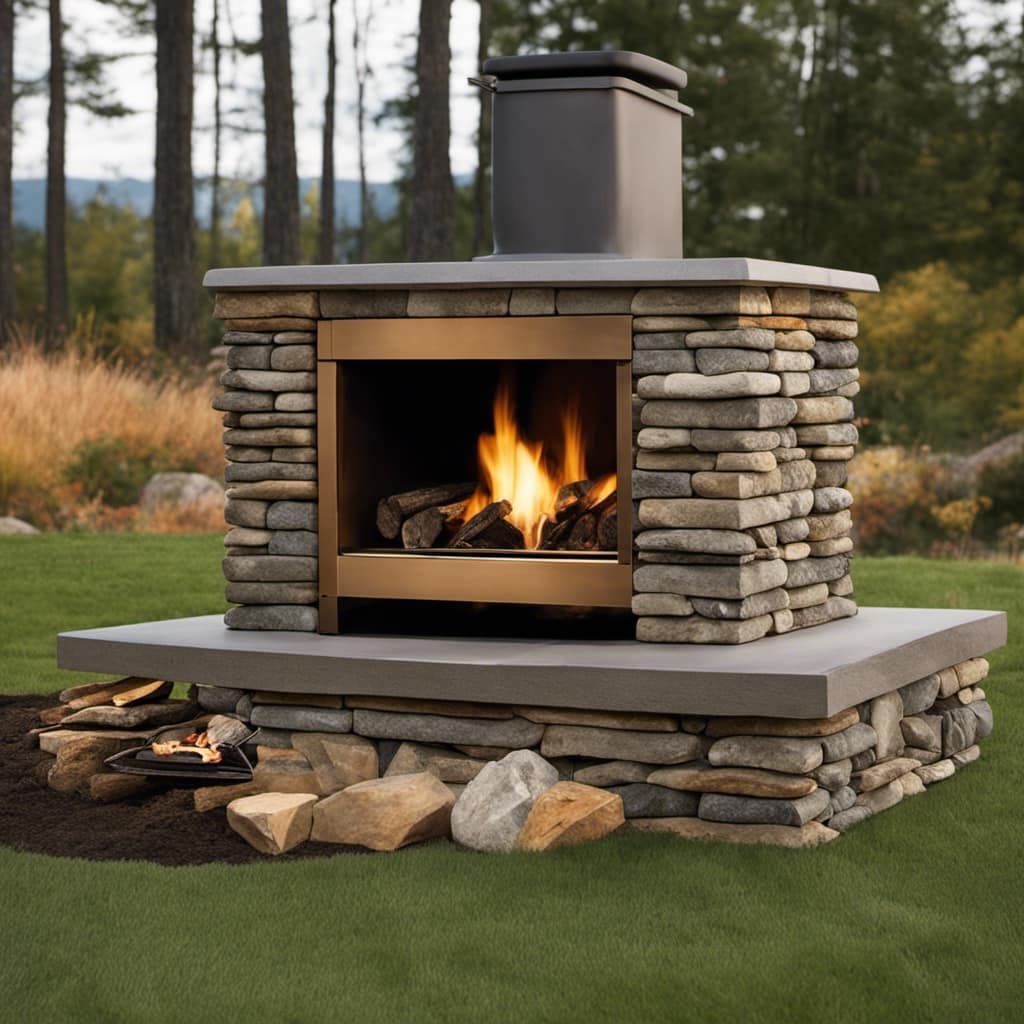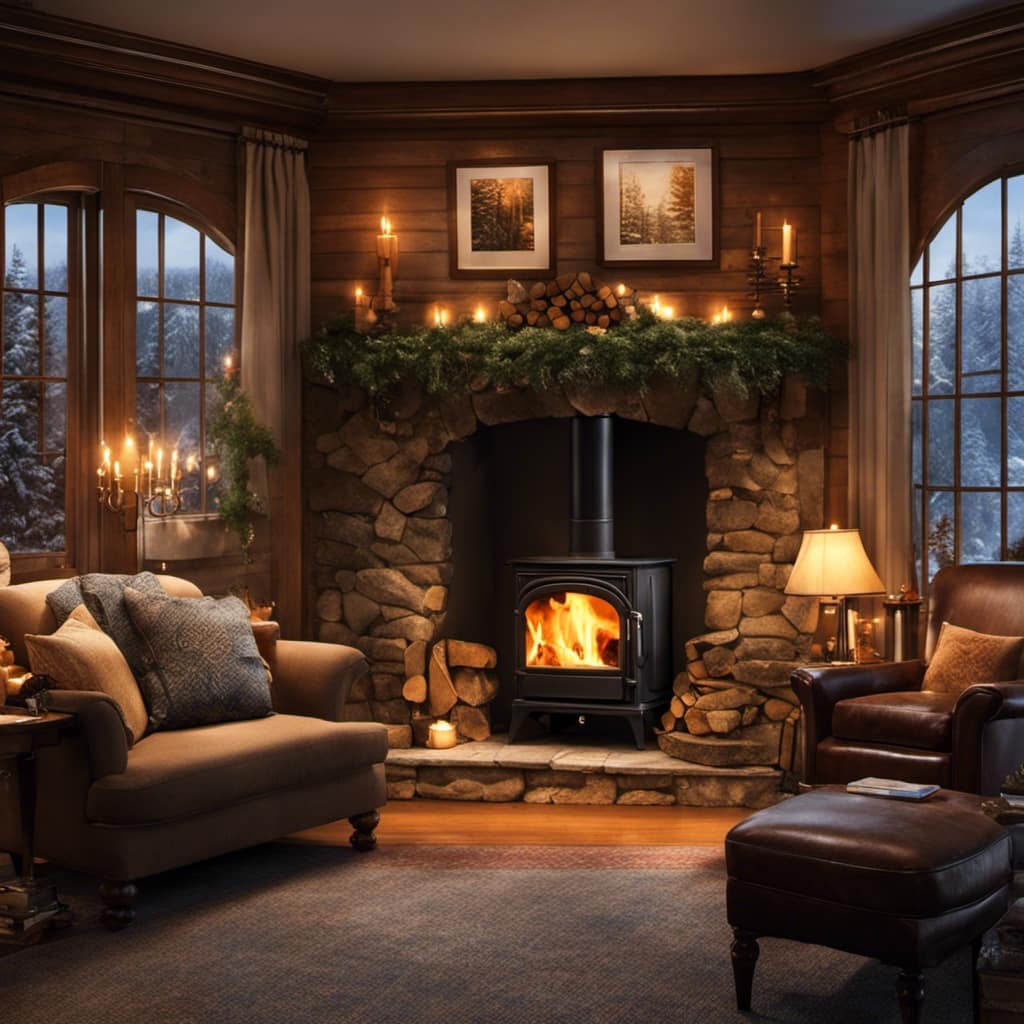Hello! Are you prepared to make your home even cozier with a wood stove insert? You’ve come to the right place! In this detailed guide, I will guide you through the steps of adding a wood stove insert to your fireplace.
From assessing your chimney to connecting and sealing the flue pipe, I’ve got you covered. So grab your tools and let’s get started on transforming your fireplace into a warm and inviting haven.
Get ready to enjoy those chilly evenings in style!
Key Takeaways
- Conduct a chimney inspection to ensure optimal performance of the wood stove.
- Measure the dimensions of the fireplace opening and consider clearance requirements.
- Gather fireproof materials and determine the required floor clearance.
- Ensure a tight connection and proper sealing of the flue pipe.
Assessing Your Fireplace and Chimney
I’ll check the condition of my fireplace and chimney before installing the wood stove insert.

It’s important to evaluate the efficiency of the existing setup to ensure optimal performance of the wood stove. The first step is to conduct a chimney inspection.
I’ll start by examining the exterior of the chimney for any signs of damage or deterioration. Cracks, loose bricks, or missing mortar can all indicate potential problems.
Next, I’ll inspect the interior of the chimney by shining a flashlight up from the fireplace opening. I’ll look for any obstructions such as debris or animal nests. It’s important to ensure that the chimney is clear and free from any blockages.
Additionally, I’ll check the damper to ensure it’s functioning properly. A stuck or damaged damper can affect the efficiency of the wood stove.

Finally, I’ll assess the fireplace itself. I’ll look for any cracks or gaps in the masonry that may need to be repaired.
Choosing the Right Wood Stove Insert
When it comes to selecting the perfect wood stove insert, it’s important to consider factors such as size, efficiency, and heating capacity. Here are some steps to guide you through the process:
Size:
- Measure the dimensions of your fireplace opening to ensure the insert will fit properly.
- Consider the clearance requirements around the insert to ensure it can be installed safely.
Efficiency:

- Look for an insert with a high energy efficiency rating. This will ensure that it effectively heats your home while minimizing fuel consumption.
- Consider features such as a secondary combustion system or a catalytic converter, which can increase the stove’s efficiency.
Heating Capacity:
- Determine the square footage of the area you want to heat and choose an insert that’s suitable for that size.
- Consider the BTU (British Thermal Unit) output of the stove to ensure it can provide enough heat for your space.
By considering these factors, you can choose a wood stove insert that’s the right size, highly efficient, and capable of heating your home effectively.
Once you’ve made your selection, it’s time to prepare the fireplace for installation.
Preparing the Fireplace for Installation
To ensure a successful installation, I need to thoroughly clean the fireplace and remove any debris or obstructions. First, I assess the fireplace safety by checking for any cracks or signs of damage. It’s important to ensure that the fireplace is structurally sound before proceeding with the installation. Next, I measure the dimensions of the fireplace opening to determine the proper fit for the wood stove insert. I carefully measure the width, height, and depth of the opening, making note of any irregularities or obstacles that may need to be addressed. Once the measurements are taken, I use these dimensions to cut the necessary pieces of insulation and mounting brackets. This step is crucial to ensure a secure and snug fit for the wood stove insert.

To convey a deeper understanding of the process, I have created a table below:
| Step | Description |
|---|---|
| 1 | Assess fireplace safety |
| 2 | Measure fireplace opening dimensions |
| 3 | Cut insulation and mounting brackets |
| 4 | Ensure secure and snug fit for insert |
Installing the Hearth and Floor Protection
To ensure the safety and functionality of your wood stove insert, it’s crucial to properly install the hearth and floor protection.
First, gather fireproof materials such as fire-resistant tiles or a non-combustible hearth pad.
Next, determine the required floor clearance according to the manufacturer’s guidelines.

Lastly, consider the design and aesthetics of your hearth, making sure it complements your overall interior decor.
Fireproof Materials for Protection
I should use fireproof materials to protect the surrounding area when installing a wood stove insert. It’s crucial to prioritize safety during the installation process to prevent any accidents or fires. Using fireproof materials is essential for a successful and safe installation. Here are some key fireproof materials to consider:
-
Fireproof Clothing:
-
Wear fire-resistant clothing, such as flame-retardant jackets and pants, to protect yourself from potential sparks or burns.
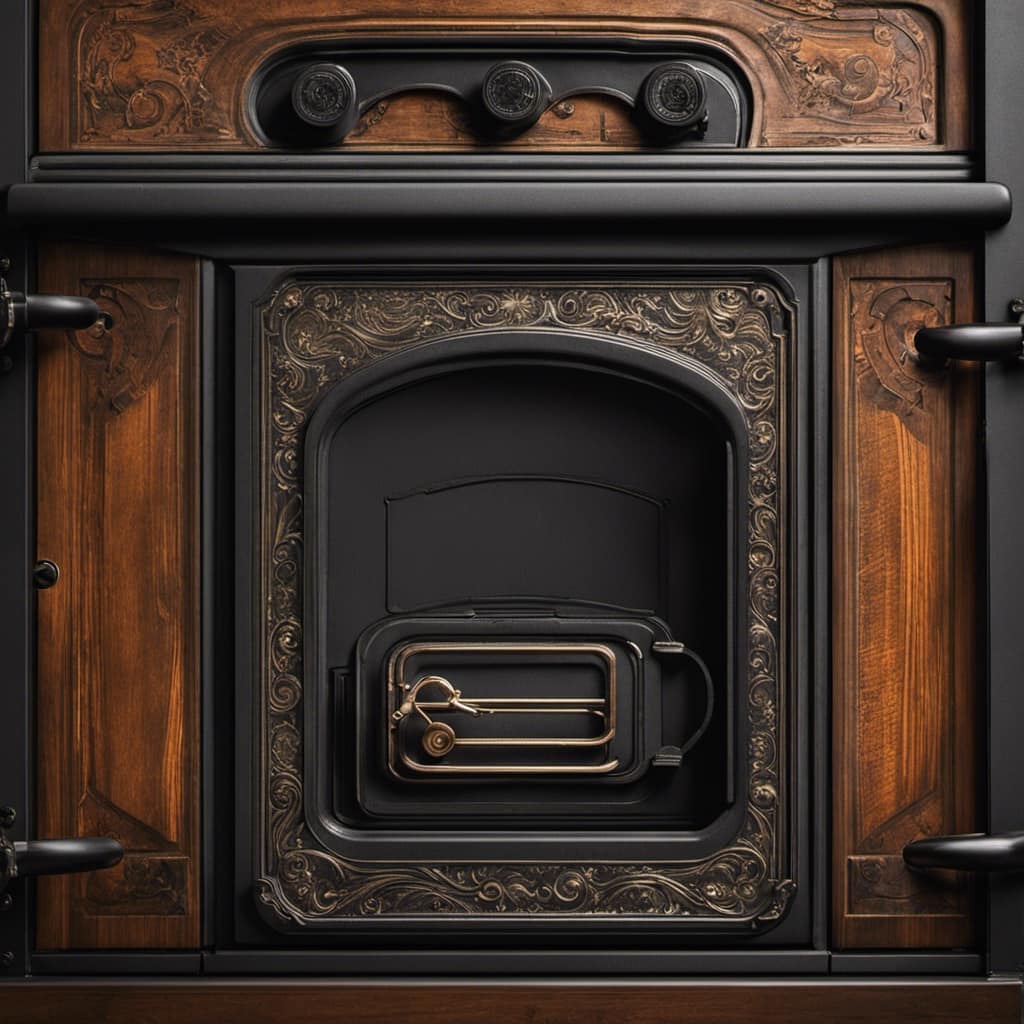
-
Fire Extinguisher Types:
-
Have a multipurpose fire extinguisher nearby, capable of handling different fire types like Class A (ordinary combustibles), Class B (flammable liquids), and Class C (electrical fires).
Proper Floor Clearance Requirements
The floor clearance requirements for a wood stove insert are crucial to follow for safety purposes. When installing a wood stove insert, it’s important to consider the type of flooring materials you’ve and adhere to local building codes.
First, check the manufacturer’s guidelines for the recommended floor clearance distance. This distance is usually specified to prevent any heat damage to the flooring.

Next, determine the type of flooring materials you’ve and make sure they meet the necessary fire resistance standards. Common flooring materials like tile, stone, or concrete are generally suitable for wood stove inserts. However, if you’ve combustible flooring materials like carpet or wood, additional measures may be required, such as installing a non-combustible hearth pad or using an approved insulating material.
Always consult local building codes to ensure compliance and ensure a safe installation.
Hearth Design Considerations
When choosing a hearth design, it’s important to consider both functionality and aesthetics. Here are some considerations to keep in mind:
-
Hearth Design Options
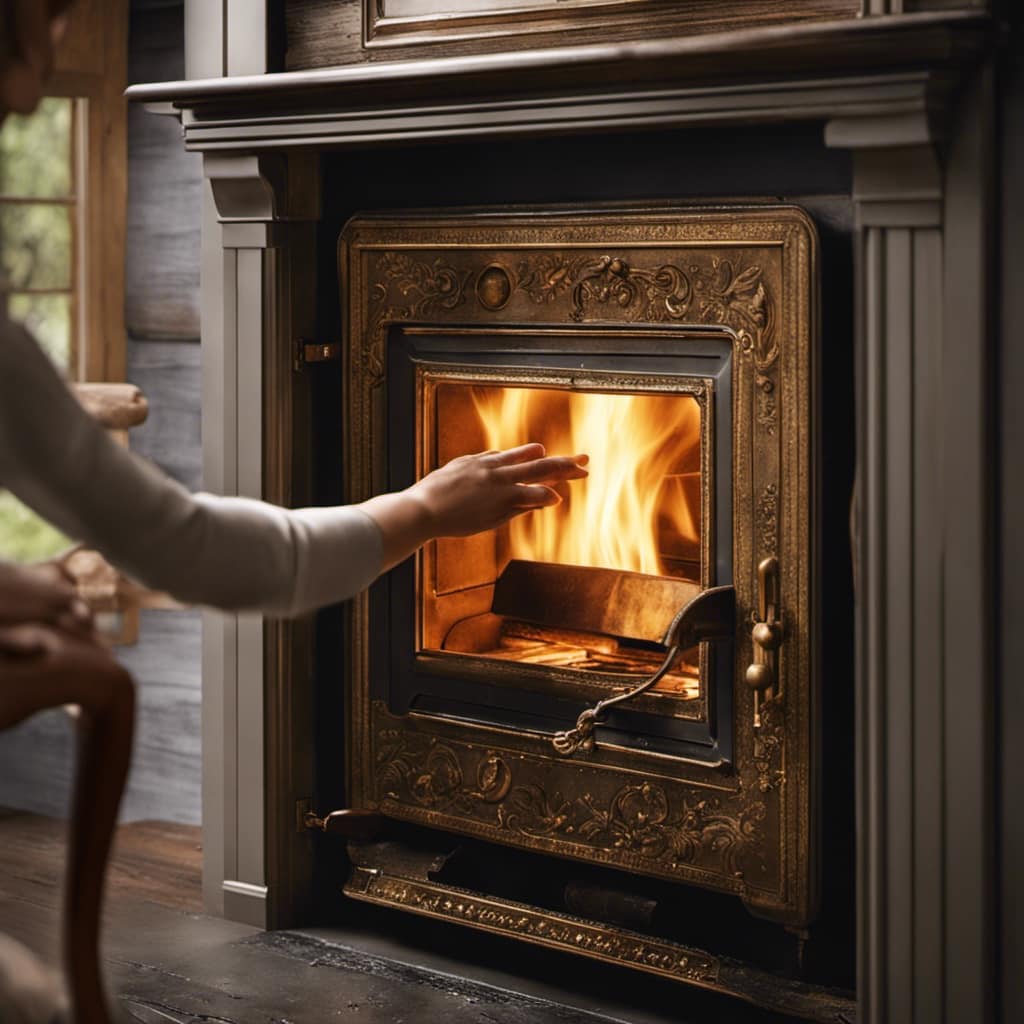
-
Traditional: A classic choice, often made of brick or stone, with a raised platform for the wood stove insert.
-
Modern: Sleek and minimalist designs that incorporate materials like glass or metal for a contemporary look.
-
Sizing Considerations
-
Dimensions: Measure the space available in your room to ensure the hearth and wood stove insert will fit properly.

-
Clearance: Check the manufacturer’s guidelines for recommended clearances around the wood stove insert to prevent fire hazards.
Connecting and Sealing the Flue Pipe
To ensure proper ventilation, I’ll connect and seal the flue pipe tightly. This step is crucial in the installation process of a wood stove insert.
Here’s a step-by-step guide on how to connect and seal the flue pipe properly.
-
Measure and cut the flue pipe: Start by measuring the distance between the wood stove insert and the chimney. Use those measurements to cut the flue pipe to the appropriate length. Make sure to use a pipe cutter to ensure clean and precise cuts.

-
Attach the flue pipe to the stove: Connect one end of the flue pipe to the outlet on the wood stove insert. Secure it tightly using screws or clamps to prevent any leaks or movement.
-
Secure the other end of the flue pipe: Slide the other end of the flue pipe into the chimney opening. Use a chimney pipe adapter to ensure a tight fit. Seal the connection with high-temperature silicone or a metal flue pipe sealant.
-
Inspect and test for leaks: Once the flue pipe is connected and sealed, visually inspect all the joints and connections. Look for any gaps or loose fittings. To test for leaks, light a small piece of paper and hold it near the joints. If the smoke gets sucked into the flue pipe, it means there’s a leak.
Securing the Wood Stove Insert in Place
To secure the wood stove insert in place, I start by anchoring it for stability. I use screws or brackets to attach the insert securely to the surrounding structure, ensuring it won’t shift or move.

Next, I follow safety measures for installation, such as leaving proper clearance from combustible materials and using a high-temperature sealant to prevent any leaks.
Lastly, I make sure to position and align the insert correctly, ensuring it’s centered and level for optimal performance and safety.
Anchoring for Stability
I can ensure stability by properly anchoring the wood stove insert. To achieve this, there are several anchoring techniques and stability assessment steps that should be followed:
-
Anchoring Techniques:
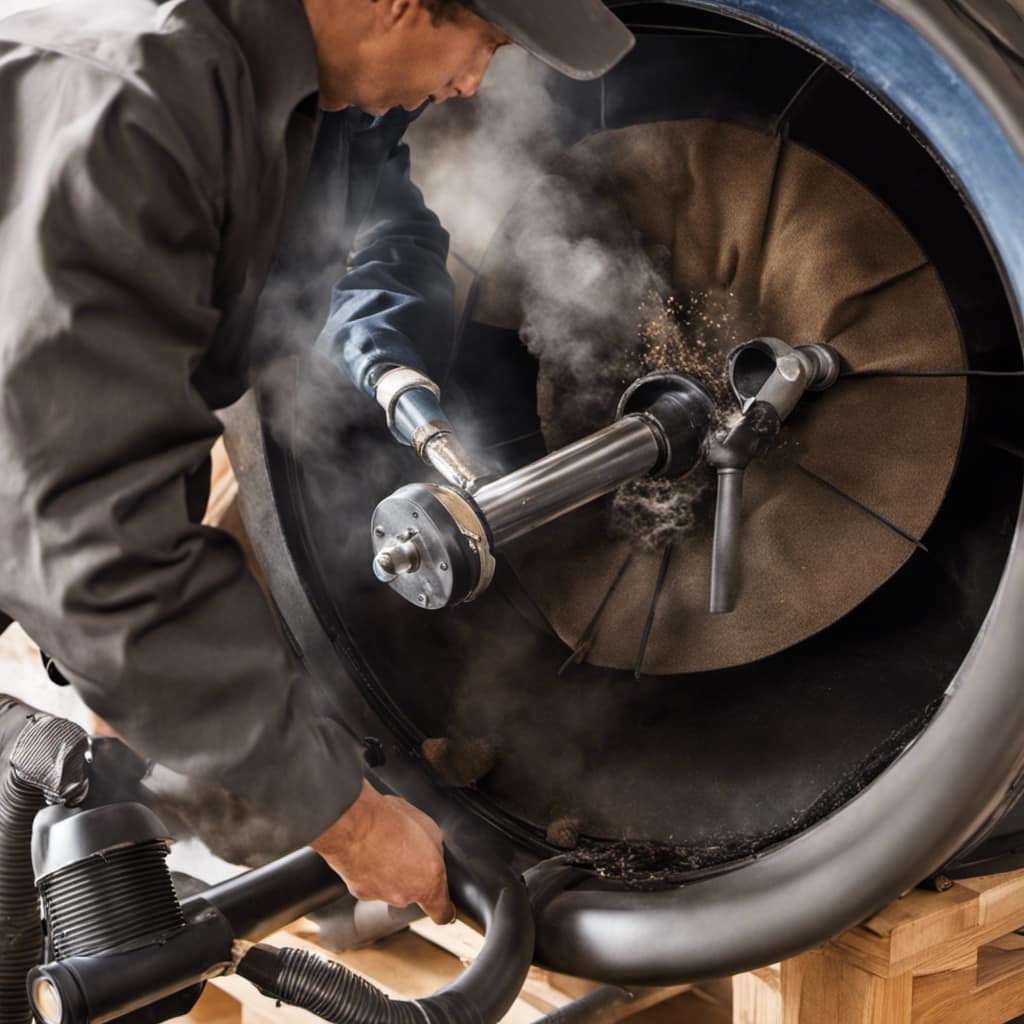
-
Use anchor brackets: These brackets are specifically designed to secure the stove insert to the floor or wall.
-
Floor bolts: These bolts go through the stove’s base and into the floor, providing a solid anchor point.
-
Stability Assessment:
-
Check for levelness: Use a level to ensure that the stove insert is sitting evenly on the floor or hearth.

-
Test for movement: Apply gentle pressure from different angles to see if the stove insert moves or wobbles.
By using these anchoring techniques and conducting a stability assessment, you can ensure that your wood stove insert is securely in place, minimizing the risk of accidents or damage.
Now, let’s move on to the next section where we’ll discuss the necessary safety measures for the installation process.
Safety Measures for Installation
When installing a wood stove, it’s important to follow safety measures to ensure a secure and hazard-free installation. Here are some key steps to keep in mind for a safe and successful installation.

First, make sure to choose the right location for your wood stove. It should be placed at least 36 inches away from any combustible materials, such as furniture or curtains.
Next, ensure proper ventilation by installing a chimney that meets local building codes. Regular chimney maintenance is crucial to prevent the buildup of creosote, which can lead to chimney fires. It’s recommended to have your chimney inspected and cleaned at least once a year.
Lastly, always remember to have a fire extinguisher nearby and install carbon monoxide detectors in your home for added safety.
Following these safety measures will help you enjoy your wood stove installation without any worries.

Proper Positioning and Alignment
When it comes to installing a wood stove insert, proper positioning and alignment are crucial. Not only does it ensure the stove’s efficiency, but it also enhances safety.
Here are some important steps to follow for proper positioning and alignment:
- Choose the right location:
- Consider the stove’s proximity to combustible materials.
- Ensure adequate clearance from walls, furniture, and curtains.
- Install proper ventilation:
- Connect the stove to a chimney or flue system.
- Ensure the chimney is in good condition and meets local codes.
- Insulation requirements:
- Use appropriate insulation materials to protect nearby walls and floors from excessive heat.
- Insulate the chimney to prevent heat loss and improve efficiency.
Testing and Adjusting the Wood Stove Insert
Before proceeding with the installation, it’s important to test and adjust the wood stove insert for optimal performance. This step will ensure that your stove operates efficiently and safely. Here are some testing procedures and troubleshooting tips to help you with this process.
First, check the air flow. Open the damper fully to allow maximum air intake. This will help create a strong fire.

Next, light a small fire using dry kindling and newspaper. Observe the flame pattern. Ideally, the flames should be steady and well-distributed across the burn area. If you notice any uneven burning or excessive smoke, it may indicate a problem with the air supply or draft.
To troubleshoot, try adjusting the damper slightly to increase or decrease the air flow. This can help regulate the burn and improve combustion. If the problem persists, check for any blockages in the chimney or stovepipe. Clear out any debris or creosote buildup that could be obstructing the airflow.
Remember, maintaining and safely operating your wood stove insert is crucial for its longevity and your safety.
Now that you’ve successfully tested and adjusted the insert, let’s move on to the next section about maintaining and safely operating your wood stove insert.

Maintaining and Safely Operating Your Wood Stove Insert
I need to regularly clean the chimney and inspect the stovepipe to ensure safe operation of my wood stove insert. Here are some safety precautions, cleaning, and maintenance steps that I follow to keep my wood stove insert in top condition:
Safety Precautions:
- Wear protective gloves and goggles when cleaning the stove.
- Make sure the stove is completely cool before starting any cleaning or maintenance tasks.
Cleaning:
- Remove ashes and debris from the firebox using a metal scoop and brush.
- Clean the glass window with a stove glass cleaner and a soft cloth.
- Use a chimney brush to clean the chimney from the top down, removing any soot or creosote buildup.
Maintenance:

- Inspect the stovepipe for any cracks, leaks, or loose connections. Replace or repair as needed.
- Check the gaskets and seals around the stove door and glass window. Replace if damaged.
- Lubricate the stove’s hinges and moving parts with a high-temperature lubricant to ensure smooth operation.
Frequently Asked Questions
How Much Does a Wood Stove Insert Typically Cost?
Wood stove insert cost can vary depending on several factors. The type of wood stove insert you choose, its size, and the materials used will all impact the price.
Additionally, installation costs should be considered. On average, wood stove inserts can range from $1,000 to $5,000, not including installation.
However, it’s important to note that these prices are just estimates and can vary based on your location and specific needs.
Can a Wood Stove Insert Be Installed in a Fireplace With an Existing Chimney?
Installing a wood stove insert in a fireplace with an existing chimney is possible and has many benefits.

The installation process involves clearing out the existing fireplace, connecting the insert to the chimney, and ensuring proper ventilation.
The benefits of a wood stove insert include increased heating efficiency, reduced energy costs, and a cozy ambiance.
It’s important to consult a professional to ensure proper installation and to adhere to safety guidelines.
Is It Necessary to Have a Professional Install a Wood Stove Insert, or Can It Be Done as a DIY Project?
Installing a wood stove insert can be done as a DIY project, but it’s important to consider safety concerns. While it may seem tempting to save money by doing it yourself, a professional installation ensures proper ventilation, chimney connection, and compliance with local codes.

They’ve the expertise to handle any obstacles that may arise during the process. Safety should always be the top priority when dealing with fire and heating appliances.
Are There Any Special Permits or Regulations That Need to Be Considered When Installing a Wood Stove Insert?
When it comes to wood stove insert installation, it’s important to consider any special permits or regulations that may be required. These regulations vary depending on your location, so it’s crucial to research and comply with local building codes.
Special permits may be needed to ensure proper ventilation, clearance from combustible materials, and compliance with safety standards.
It’s always a good idea to consult with a professional or local authorities to ensure that you’re meeting all necessary requirements.

How Often Should the Chimney and Flue Pipe Be Cleaned and Inspected to Ensure Safe Operation of the Wood Stove Insert?
To ensure safe operation of a wood stove insert, it’s crucial to regularly clean and inspect the chimney and flue pipe. The frequency of cleaning and inspection depends on various factors, such as the type of wood used and the frequency of use.
Generally, it’s recommended to have the chimney and flue pipe cleaned and inspected at least once a year. Signs that indicate the need for cleaning or repair include excessive smoke, a strong odor, or a buildup of creosote.
Conclusion
In conclusion, installing a wood stove insert can be a rewarding and practical addition to your home. By carefully assessing your fireplace and chimney, choosing the right insert, and following the step-by-step installation process, you can enjoy the warmth and efficiency of a wood stove.
Remember, knowledge is the key that unlocks the door to a cozy and inviting atmosphere in your living space. So, let the flames of knowledge guide you on this exciting journey.

Growing up surrounded by the vast beauty of nature, Sierra was always drawn to the call of the wild. While others sought the comfort of the familiar, she ventured out, embracing the unpredictable and finding stories in the heartbeat of nature.
At the epicenter of every remarkable venture lies a dynamic team—a fusion of diverse talents, visions, and passions. The essence of Best Small Wood Stoves is crafted and refined by such a trio: Sierra, Logan, and Terra. Their collective expertise has transformed the platform into a leading authority on small wood stoves, radiating warmth and knowledge in equal measure.

